Lampros Hall Information Technology Display Proposal
Background: For several years one of the Systems/Network Management engineers, Bill Clark, has collected old computer artifacts and displayed them in a small, glass front case in the Help Desk lobby of the Technical Education Building, room 209. The collection has increased over time and the display case is currently in ‘overfill’. Students have enjoyed viewing the display as they wait for assistance at the Help Desk and comments of the nature “oh, my dad used to have one of those” or “when did they use floppy disks that big?” are frequently overheard. Several instructors from Computer Science and Information Systems and Technologies have included tours of the display as part of the course. Several times browsers of the display indicate they have something in their basement that would be “great to add”. In addition to Bill Clark’s collection, there is also some very interesting communication technology available through Barbara LeDuc.
Justification for proposal: The development of the Lampros Hall Technology Center is a wonderful opportunity to expand the current technology display and the communication technology and make it accessible to a larger audience. This can occur without taking away from too much programmed space inLampros Hall and by making use of empty wall space a display could be developed that would allow for expansion of the present setup and the creation of a professional looking display. The focal point of Lampros Hall, technology, makes it an ideal home for the display. The fun atmosphere of a display would be a nice complement to the general business of the Technology Center; research, testing, and education.
Proposal: In the northwest corner on the first floor of Lampros Hall a small, 9.5’ x 10.0’ foot breakout room is programmed. Just outside that breakout room is wall space measuring 19’ in length. The proposal is to use some wall space in the breakout room and the wall space outside, outfitted with appropriate display cases and lighting as the display. In addition, some wall space throughout the building could accommodate flat displays as part of the display/educational experience.
Funding scope: Display cases for the area will probably cost in the range of $7500 - $8500. Setup, cataloging of artifacts, and day to day maintenance will be done by volunteers from the IT division, Computer Science, and other parties that have expressed interest. The display has the verbal backing of the ARCC (Academic Resources and Computing Committee) and will conceivably receive some financial backing from that group as well. It should also be noted that the display has the backing of the three principal occupants of the building – Tech support, multimedia services, and continuing education.
POTENTIAL:
Students:
As noted, a number of instructors have used the materials already show-cased at the help desk to illustrate concepts in computing. The intent is to first make these artifacts more instructive by documenting them. However, the originators wish to go further, they want this into not only as a showcase of the technologies but a showcase that recognizes the historical and sociological context. Even further, the originators wish to make the artifacts “come alive” by using dynamic elements on the web, in person through simulations, or through working artifacts themselves: an “Exploratorium” if you will.
Service Learning Efforts for students and professors:
The project offers many service learning opportunities in its construction. The originators view this as an ongoing process; the display building over time; and this will give plenty of time for contributions from many different groups. Individuals in Visual Arts, English, TBE, History, Computer Science, IS&T, as well as the IT division, have expressed interest in participating. Documenting the artifacts and making them “come alive” will allow for many learning opportunities for diverse Weber State Students in individual and group projects. Recently, many professors (including one of the display originators) and administrators in the university have returned from a service learning retreat at Snowbird. The goal of service learning is being taken seriously at a high level within the university. The opportunity to use university talents for creating the display benefits students, faculty, and offers lower cost labor as well.
Community:
The potential exists to develop this display into a historical showcase that will be of interest not only to the WSU community, but the general community as well. As noted above, the possibility of developing ‘hands on’ displays exists. Students can learn that Utah is also home to many ‘firsts’ and interesting developments in computing history. For example, when ARPANET – basically the origins of the internet – was turned on in 1969, a computer in Utah was one of the four nodes. We also have had numerous corporations that were important for the origins of the computing field here; Iomega and Novell to name two. In addition, given the importance of computing in almost all fields, this would be an interesting “field trip” location for classes in math, science, history, computers, and more.
Bottom Lines:
- Minimal costs to create and operate.
- Allow for creation of display through service learning efforts that benefit university students and professors.
- Create an initial offering that opens with Lampros opening but build display over time.
- Over time, turn the display into an Exploratorium that allows for interaction.
- Display offerings are a benefit to university students studying technology and culture.
- Display offerings can benefit the community as a “field trip” destination.
Photos
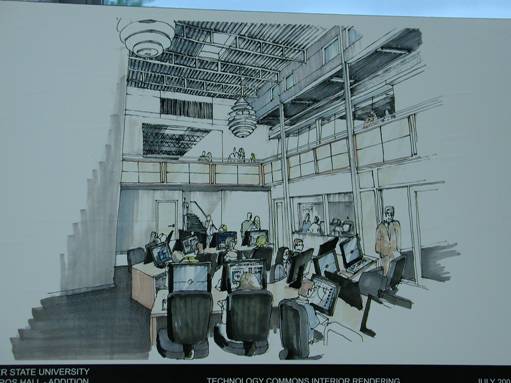
Interiro view of Lampros Hall
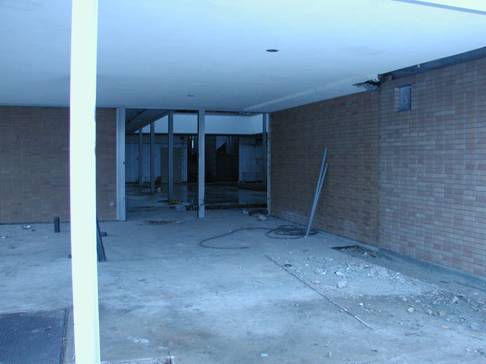
Exterior shot of Atrium. Wall considered is back right.
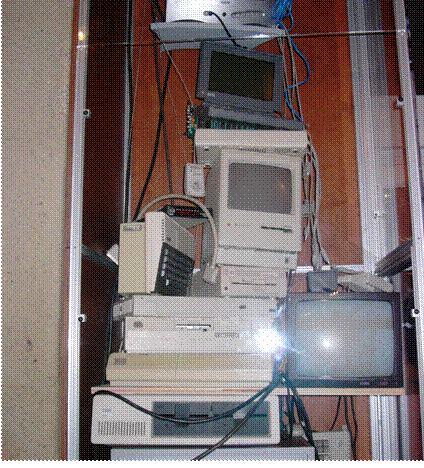
Boston Museum of Science Computer - Tower of hardware to the left of the main entrance to display
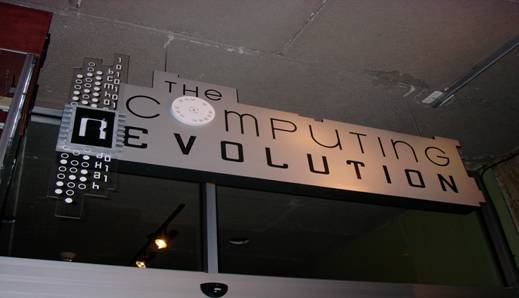
Boston Museum of Science Computer - Sign above entrance to display
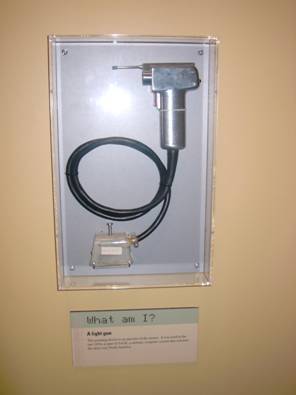
50s SAGE light sun

Ancient Computers

This is a visual display unit that contains a computer with only a few buttons and a scroll wheel available to patron

Atari 800

National Semiconductor Calculator

Core Memory
Proposal for Visual Arts collaboration for Display creation
Personally, I’m pretty excited by this project, as are those that are now deeply involved. I think we can make this look really good.
There are a number of possible projects and levels of involvement here. I would anticipate that I would have to give a presentation, show anyone interested from visual arts all the artifacts, pictures I have, etc. They could also join in on a brainstorming session with the Lampros IT display team. I really don’t know how you want to organize it – my hope would be to allow you to be involved at the level of commitment you can afford. Any help in organization, therefore, I can offer.
- Work with display committee on coming up with display approach. Originally we had just thought of putting in shelving units; but that could end up being something more interesting if someone wanted to work on creating interesting plywood and Plexiglas components – or at least designing them and help us find where to get them built if you have connections.
- Work with committee on creating the web page that will parallel the display.
- Work on nicely digitally photographing the artifacts that exist for use on web site and documenting the artifacts. (It would be nice if this happened fairly soon for I could use the photos for another group that is documenting and research)
- Work on creating a design for plaques that sit next to or attach to artifacts.
p.s. The color scheme for the interior of the building is being changed slightly. Jim Harris will help me (or a student) supply this when it is finalized, likely by end of January.
4-18-04: As of this date there is one student doing a final project. She should have a display model completed in Summer of 2004.
Proposal for English Tech Writing collaboration for Display creation
The key aspect of this is to document the existing artifacts as to what they are, where they came from, significance to Weber State, who donated, and some historical significance of the artifacts in the IT world and general social economy. The pictures are currently compiled and available as part of this. A spreadsheet exists and is being updated with the information. Becky Jo McShane is coordinating this. In Spring 2004 there is one group doing a semester long project regarding this led by Louis Aponte.
Proposal for Library collaboration for Display creation
The key aspect of this is to create an annotated bibliography for use with researching the artifacts as well as adding the information to the virtual display (website). JaNae Kinikin is heading this effort.
Proposal for Computer Science collaboration for Display creation
There are several key aspects of this. One is to create prototype pages devoted to particular technology artifacts. Currently the cs3350 Internet Programming class is devoted to this. In addition, several individual final projects related to cs3350 are working on a server side program devoted to creating a database that will serve up photographs and text – allowing for the user to dynamically generate pages of interesting technology. Finally, one student (Louis Aponte) is interested in doing a senior project related to interviewing users of the artifacts. David Ferro is doing this work.
Proposal for History collaboration for Display creation
The key aspect of this is to create a oral history of the artifacts, including audio/video recording of their words. In addition, to review the history of computer displays. This is planned for Fall 2004. Kathryn Mackay is heading this up.
Proposal for TBE and/or Visual Arts collaboration for Display creation
The key aspect of this is to create a presentable web interface second version prototype for the virtual display. This is planned for Fall 2004. Laura Anderson of TBE is heading this up for TBE. The Visual Arts is not set yet.
